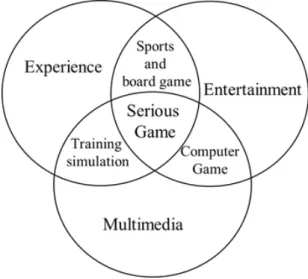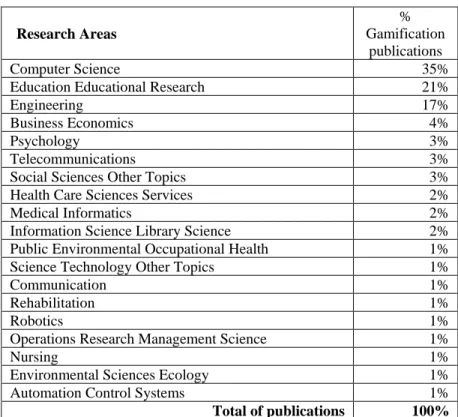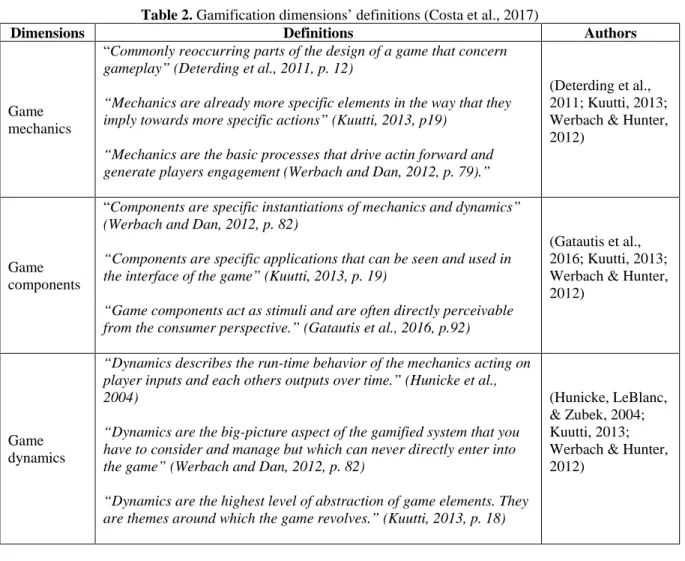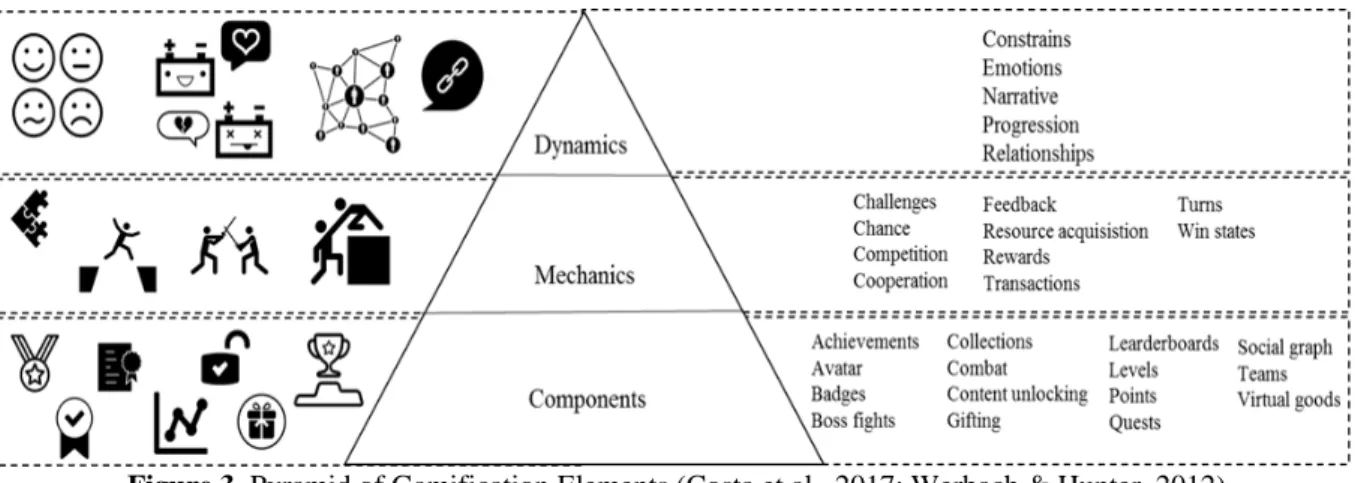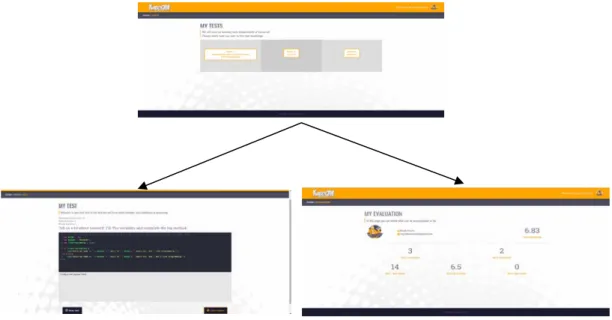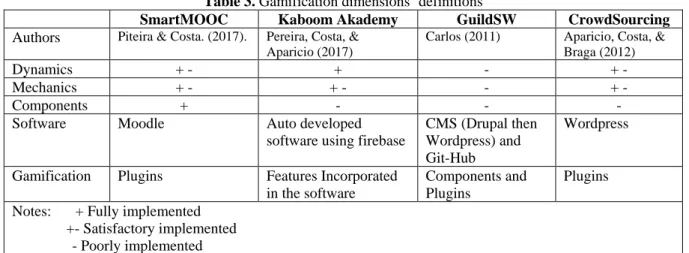GAMIFICATION: SOFTWARE USAGE ECOLOGY
Carlos J. Costa
ISEG School of Economics and Management of the Universidade de Lisboa, Portugal Instituto Universitario de Lisboa (ISCTE-IUL) ISTAR-IUL
carlos.costa@acm.org
Manuela Aparicio
Instituto Universitario de Lisboa (ISCTE-IUL) ISTAR-IUL Nova IMS, Universidade Nova de Lisboa, Portugal
manuela.aparicio@acm.org
Abstract: Gamification is applied in academia and industry and is being studied in the last
years. Gamification is nowadays applied to several areas, such as learning, computer science, business, marketing, tourism, among others. Research performed till now suggests that its usage may improve students' and workers' motivation and increase study, productivity and sales. Nevertheless, there are many forms of implementing, according to each industry. Supported in the literature, we identified the game components, game mechanics, and game dynamics, used as part of any gamification implementation. Then, we selected some specific cases in e-learning, computer program learning, open source software development, and crowdsourcing. Finally, we list some of the main software employed in this fields, identifying also implemented features. This allowed us to find the great complexity and variety of implementations. It also enabled us to find ether practitioners or researcher use the word gamification for a broad range of approaches.
Keywords: Gamification, Game Design, Gamification Tools, Software
Introduction
Gamification has increased awareness since its definition, (Google, 2017). Google Scholar indexes 8,660 scientific publications in 2016, and in 2011, the year when the concept was coined, 481 publications. Gamification reached the peak of popularity in 2014 (Google, 2017). Gamification corresponds to the “use of game elements, in non- game context”(Deterding, Dixon, Khaled, & Nacke, 2011, p. 9), with the objective of achieving individuals’ engagement towards defined goals. In several studies, gamification concept is used with other concepts, for example, simulation, game, and serious games (Deterding et al., 2011). The gamification concept has been used in several contexts, mainly related with education, management, simulations of real situations, serious games, gaming, e-banking, and marketing (Costa & Aparício, 2006; Costa, Aparicio, Aparicio, & Aparicio, 2017; Costa & Costa, 2010; Costa & Costa, 2010; Manuela Aparicio, 1999; Miller, 2013; Rodrigues, Costa, & Oliveira, 2014, 2016). Authors have applied game-design elements, game principles, and game mechanics in non-game contexts (Bunchball, 2010; Deterding et al., 2011; Slegers, Ruelens, Vissers, & Duysburgh, 2015).
The main goal of this paper is to identify the game components, game mechanics, and game dynamics, used as part of gamification implementation. The methodological approach of this paper follows a documental study method. First, it is made a review on the theoretical background on the topic, then applying a theoretical framework, we analyze a set of cases.
The paper is structured in two main parts. The first part is related to the literature review on gamification and associated concepts. The second part relates to the presentation of each study case and analysis of the elements and software used to instantiate gamification on the several contexts. Finally, we present the conclusions of our analysis.
Gamification Vs Other Concepts
The gamification concept was coined in 2011 by Deterding et al. (2011), the definition has been used since then and states for “Gamification is the use of game design elements in non-game contexts.” (Deterding et al., 2011, p. 9). Although gamification concept derives from the word game, it does not inevitably suggest gaming, or
than pure entertainment. Systems like teaching games, simulators, meaningful games, and purposeful games. Figure 1 shows the overlaps between experience, entertainment, and multimedia, which corresponds to serious games.
Figure 1. Serious games based on (Costa et al., 2017; Laamarti, Eid, & Saddik, 2014)
Students can learn using real gameplay environment, the game is not designed for playful purposes, but it serves as a simulator of a real scenario in a virtual version set. These virtual learning scenarios are extracted from the real world, and allow a safe learning environment for practising and testing knowledge. A “meaningful game” uses gameplay to endorse a specific message to the player. A “purposeful Game” creates certain outcomes directly into the real world. These terms lead conceptually to the term “gameful design”, corresponding to a process, where “game thinking” has been used (Marczewski, 2013). Figure 2 illustrates the main differences between these concepts. From the figure, one can conclude that the unique characteristic which is present in a game and is no present on other contexts is the playfulness just for fun purpose. Game thinking is present in the game inspired design, in gamification, in serious games, and in games. Gamification does not comprehend playing a game just for fun or playing a game for that matter. Gamification uses “game thinking” and “game mechanics” in non-playful contexts to engage users in solving problems.
Figure 2. Gamethinking, broken down by design goals (Marczewski, 2013)
Gamification is implemented in applications and processes to improve user engagement, return on investment, data quality, timeliness, and learning. From a bibliometric study results showed the evolution of these concepts two main digital libraries, verifying that gamification studies registered a considerable increase throughout the years, whereas the related concepts registered a decreased in both digital libraries (Costa et al., 2017). From that same study, the authors found that “Gamification” term or “Gamified” is mainly related to other keywords, such as motivation, serious games, crowdsourcing, engagement, user experience, learning, and design. The terms evolution registered a crescent tendency of the relationship between “gamification”, “engagement” and “user experience”. These results may also indicate that new areas of research are arising. It was observed that researchers are transposing gamification into other areas, rather than pure technology engineering, education, learning, e-learning, design, motivation, games, crowdsourcing, collaboration, behavior, software, games, design, interaction, engagement, motivation, technology, experience, enterprise, and serious, are among the most studied topics. From the previous analysis, we verified the progress of gamification related terms and concepts. From the Web of Science directed searches (WoS, 2017), we found the scientific fields related to gamification Table 1.
Table 1. Gamification relation with other scientific fields (Costa et al., 2017)
Research Areas
% Gamification
publications
Computer Science 35%
Education Educational Research 21%
Engineering 17%
Business Economics 4%
Psychology 3%
Telecommunications 3%
Social Sciences Other Topics 3%
Health Care Sciences Services 2%
Medical Informatics 2%
Information Science Library Science 2%
Public Environmental Occupational Health 1%
Science Technology Other Topics 1%
Communication 1%
Rehabilitation 1%
Robotics 1%
Operations Research Management Science 1%
Nursing 1%
Environmental Sciences Ecology 1%
Automation Control Systems 1%
models, and in fifth game design methods (Deterding et al., 2011). Some authors refer to “game elements”, however elements may also refer to components in some studies, therefore instead of elements, we refer in this study as game dimensions. The way these dimensions are aggregated differ from framework to framework, and from model to model. Table 2 presents various definitions according to different levels of dimensions. To operationalize these concepts, researchers and practitioners developed several approaches, among the most used we can find: Octalysis, (2015), Werbach and Hunter model (2015), and a recent model named Gamification Model Canvas (Jiménez, 2015).
Table 2. Gamification dimensions’ definitions (Costa et al., 2017)
Dimensions Definitions Authors
Game mechanics
“Commonly reoccurring parts of the design of a game that concern gameplay” (Deterding et al., 2011, p. 12)
“Mechanics are already more specific elements in the way that they imply towards more specific actions” (Kuutti, 2013, p19)
“Mechanics are the basic processes that drive actin forward and generate players engagement (Werbach and Dan, 2012, p. 79).”
(Deterding et al., 2011; Kuutti, 2013; Werbach & Hunter, 2012)
Game components
“Components are specific instantiations of mechanics and dynamics” (Werbach and Dan, 2012, p. 82)
“Components are specific applications that can be seen and used in the interface of the game” (Kuutti, 2013, p. 19)
“Game components act as stimuli and are often directly perceivable from the consumer perspective.” (Gatautis et al., 2016, p.92)
(Gatautis et al., 2016; Kuutti, 2013; Werbach & Hunter, 2012)
Game dynamics
“Dynamics describes the run-time behavior of the mechanics acting on player inputs and each others outputs over time.” (Hunicke et al., 2004)
“Dynamics are the big-picture aspect of the gamified system that you have to consider and manage but which can never directly enter into the game” (Werbach and Dan, 2012, p. 82)
“Dynamics are the highest level of abstraction of game elements. They are themes around which the game revolves.” (Kuutti, 2013, p. 18)
(Hunicke, LeBlanc, & Zubek, 2004; Kuutti, 2013; Werbach & Hunter, 2012)
Figure 3 pictures a combination of the gamification pyramid containing the elements based on the hierarchy proposed by Werbach and Hunter (Werbach & Hunter, 2015), and the literature review which instanciates those dimensions (Costa et al., 2017). Those three elements, dynamics, components, and mechanics characterize different interconnected levels, for example, defining the design principles (Dynamics) is crucial to choose the adequate actions structures (Mechanics) to select the suitable interface level displays (Components).
Figure 3. Pyramid of Gamification Elements (Costa et al., 2017; Werbach & Hunter, 2012)
Figure 3 depicts on the left side iconography associated with the different levels of gamification dimensions. Game dynamics usually are instantiated in emotions, constraints, progression perception, narratives, and relationships. Game mechanics correspond mainly to a set of actions or processes which implement the challenges, feedback, cooperation or competition, rewards systems, among others. Mechanics define the guidelines, for example suggesting that if the user watches a video, or do a quiz, gets extra points to unlock the next level. Components are more “tangible” elements, as for example, we usually find badges, avatars, achievements’ boards, gifts, points, just to exemplify.
The next section presents four different cases where gamification elements were introduced, describing the main objectives and contexts of application.
Cases
Case 1: SmartMOOC
This case corresponds to a solution presented to the problem of improving computer programming, especially in the first year of college (Piteira & Costa, 2017). This solution has as the main purpose helping the student learning programming. The emphasis is on the core concepts of programming (Figure 4), like variables, control structures. The language uses JAVA. The solution was implemented using Moodle (http://iscte.acm.org/elearning/). The purpose of using Gamification was to improve motivation of the students. The narrative used is very related to a traditional lecture with some exercises. This study is still undergoing, and the final was not reported yet.
Figure 5. Prototype of Kaboom Akademy
Case 3: Guild Software Development
This solution started as a need to support an open source community around an open source application (Costa, 2011). The solution initially proposed was supported in Drupal. Then, it evolved to Wordpress. Other software and services were also used, like Github. Gamification was proposed as a way of motivating the community and improve engagement in the project. The narrative is related to a metaphor of a middle age craft guild (figure 6), where the user starts as an apprentice, and then became a journeyman and ended as master. There is also several types of the user using the same hierarchy: end user (brothers), the developer (craftsman), testers (worriers).
Case 4: Crowdsourcing
This solution started generic solution to support crowdsourcing projects (Aparicio et al., 2012). The solution was developed using WordPress as the main platform. Then, several plugins were used to support the implementation of gamification. The purpose of using Gamification was to improve motivation of the potential participants.
Figure 7. System to support crowdsourcing
Summarizing Cases
Table 3. Gamification dimensions’ definitions
SmartMOOC Kaboom Akademy GuildSW CrowdSourcing
Authors Piteira & Costa. (2017). Pereira, Costa, & Aparicio (2017)
Carlos (2011) Aparicio, Costa, & Braga (2012)
Dynamics + - + - + -
Mechanics + - + - - + -
Components + - - -
Software Moodle Auto developed
software using firebase
CMS (Drupal then Wordpress) and Git-Hub
Wordpress
Gamification Plugins Features Incorporated in the software
Components and Plugins
Plugins Notes: + Fully implemented
+- Satisfactory implemented - Poorly implemented
Conclusions
Gamification is widely employed and disseminated in the corporate context. In order to analyse how software is used to support gamification, we study four cases. Two cases were related to e-learning (SmartMOOC and Kaboom Akademy), one case was related to software engineering, and open source (GuildSW) and another case was related to crowdsourcing (CrowdSourcing). The technology used was different according to the case. Moodle was used in SmartMOOC. In the Case CrowdSourcing, it developed a solution supported in Wordpress. In both projects, plugins were used to implement gamification. Kaboom Akademy is a more informal project, but main purposes are very similar to the purposes of SmartMOOC. GuildSW had a more troubled process. In what concerns, conceptual solution, it was very stable. However, the implementation changed significantly. Originally the implementation was supported in the Drupal. However, then, it changed to WordPress using plugins. However, there was also a need of connecting other tools and services, like Github. In what concerns level of dynamics, mechanics and components implementation change significantly.
of the 35th ACM International Conference on the Design of Communication (p. 2:1–2:9). New York, NY, USA: ACM. https://doi.org/10.1145/3121113.3121205
Costa, C. J., & Costa, P. (2010). Wemoga: walking through a map. In Proceedings of the Workshop on Open Source and Design of Communication (pp. 61–63). New York, NY, USA: ACM.
https://doi.org/10.1145/1936755.1936775
Costa, J. P., & Costa, C. J. (2010). Market game. In Proceedings of the Workshop on Open Source and Design of Communication (pp. 59–60). New York, NY, USA: ACM. https://doi.org/10.1145/1936755.1936774 Deterding, S., Dixon, D., Khaled, R., & Nacke, L. (2011). From Game Design Elements to Gamefulness:
Defining “Gamification.” In Proceedings of the 15th International Academic MindTrek Conference: Envisioning Future Media Environments (pp. 9–15). New York, NY, USA: ACM.
https://doi.org/10.1145/2181037.2181040
Gatautis, R., Vitkauskaite, E., Gadeikiene, A., & Piligrimiene, Z. (2016). Gamification as a Mean of Driving Online Consumer Behaviour: SOR Model Perspective. Engineering Economics, 27(1), 90–97. Google. (2017). Google Trends. Retrieved from /trends/explore
Hunicke, R., LeBlanc, M., & Zubek, R. (2004). MDA: A formal approach to game design and game research (Vol. 4). Presented at the Proceedings of the AAAI Workshop on Challenges in Game AI.
Jiménez, S. (2015). Gamification model canvas. Retrieved July, 10, 2016.
Kuutti, J. (2013). Designing gamification. University of Oulu, Oulu Business School.
Laamarti, F., Eid, M., & Saddik, A. E. (2014). An overview of serious games. International Journal of Computer Games Technology, 2014, 11.
Manuela Aparicio, C. J. C. (1999). Utilizacao do Jogo de Simulacao de Gestao SIM 7 como Instrumento Pedagogico: Um Estudo Exploratorio. Revista Portuguesa de Marketing, 3(7), 75–85.
Marczewski, A. (2013). What’s the difference between Gamification and Serious Games. Andrzej’s Blog. Miller, C. (2013). The Gamification Of Education. Developments in Business Simulation and Experiential
Learning, 40(0). Retrieved from https://journals.tdl.org/absel/index.php/absel/article/view/40
Octalysis: Complete Gamification Framework - Yu-kai Chou. (2015, March 1). Retrieved April 14, 2017, from http://yukaichou.com/gamification-examples/octalysis-complete-gamification-framework/
Pañella, O. G. (2012). Game Design and e-Health: Serious Games put to the test. Advancing Cancer Education and Healthy Living in Our Communities: Putting Visions and Innovations Into Action. Selected Papers from the St. Jude Cure4Kids® Global Summit 2011, 172, 71.
Pereira, R., Costa, C. J., & Aparicio, J. T. (2017). Gamification to support programming learning. In Information Systems and Technologies (CISTI), 2017 12th Iberian Conference on (pp. 1–6). IEEE. Retrieved from http://ieeexplore.ieee.org/abstract/document/7975788/
Piteira, M., & Costa, C. J. (2017). Gamification: Conceptual framework to online courses of learning computer programming. In 2017 12th Iberian Conference on Information Systems and Technologies (CISTI) (pp. 1–7). https://doi.org/10.23919/CISTI.2017.7975695
Rodrigues, L. F., Costa, C. J., & Oliveira, A. (2014). How Gamification Can Influence the Web Design and the Customer to Use the e-Banking Systems. In Proceedings of the International Conference on Information Systems and Design of Communication (pp. 35–44). New York, NY, USA: ACM.
https://doi.org/10.1145/2618168.2618174
Rodrigues, L. F., Costa, C. J., & Oliveira, A. (2016). Gamification: A framework for designing software in e-banking. Computers in Human Behavior, 62, 620–634. https://doi.org/10.1016/j.chb.2016.04.035 Schell, J. (2008). The Art of Game Design: A Book of Lenses. San Francisco, CA, USA: Morgan Kaufmann
Publishers Inc.
Slegers, K., Ruelens, S., Vissers, J., & Duysburgh, P. (2015). Using game principles in ux research: A board game for eliciting future user needs (pp. 1225–1228). Presented at the Proceedings of the 33rd Annual ACM Conference on Human Factors in Computing Systems, ACM.
Werbach, K., & Hunter, D. (2012). For the Win: How Game Thinking Can Revolutionize Your Business. Wharton Digital Press.
Werbach, K., & Hunter, D. (2015). The Gamification Toolkit: Dynamics, Mechanics, and Components for the Win. Wharton Digital Press.
WoS. (2017). Web of Science - Please Sign In to Access Web of Science. Retrieved April 13, 2017, from https://login.webofknowledge.com/
